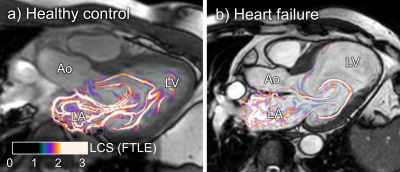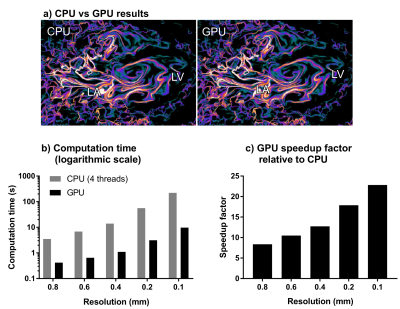4786
Cloud-based, GPU-accelerated computation of Lagrangian Coherent Structures in 4D flow enables near-instant blood flow visualization1Skane University Hospital, Department of Clinical Sciences Lund, Clinical Physiology, Lund University, Lund, Sweden
Synopsis
Intracardiac blood flow dynamics depicted using 4D flow magnetic resonance imaging is increasingly used for analysis of cardiac health. Lagrangian Coherent Structures (LCS) is a powerful blood flow analysis tool, with applications in diastolic dysfunction and separating flowing blood with different behavior. However, use of LCS has been limited by long computation times. Therefore, a cloud-based computation engine for LCS analysis was developed, incorporating acceleration with graphical processing units (GPU:s). A speedup factor of up to 23 times is realized, enabling sub-second LCS computation times. Furthermore, the cloud platform makes rapid LCS analysis possible without investing in expensive GPU hardware.
Background
Lagrangian Coherent Structures (LCS) computed from 4D flow magnetic resonance is a recently introduced method (1) for analysis of intracardiac blood flow (Figure 1). LCS have been used to quantify diastolic dysfunction (2) and to reveal the epigenetic coupling between blood flow and myocardial dynamics (3). However, LCS analysis is limited by long computation times. Therefore, this study aims to investigate if acceleration using cloud-based graphical processing units (GPU) can reduce computation time compared to standard processors (CPU).Methods
The original LCS code (1) was adapted to the Compute Unified Device Architecture (CUDA, NVIDIA, Santa Clara, CA, USA) for GPU execution. To verify correctness, LCS images were compared between GPU code and original code.
Benchmarking was performed in one subject (Figure 1) at different resolutions from 0.8 mm (6×104 pixels, 1.8×104 particle traces) to 0.1 mm (3.8×106 pixels, 1.1×107 traces). Total execution time was recorded for CPU and GPU computation on the same cloud instance (Amazon Web Services g2.2xlarge, 4 CPU threads, NVIDIA K520 GRID GPU).
Results
The new cloud-based GPU version of the LCS computation gives identical results compared to the original CPU-based version (1) (Figure 1a). Computation times were lower for the GPU compared to the CPU (3±4 vs 60±92 seconds, Figure 1b), with a median speedup factor of 12.7 (range 8-23). Finer resolutions gave higher speedup factors (linear regression: R2=0.92, p=0.011). At 0.8 mm resolution, the LCS image was computed in 0.54 seconds on the cloud GPU version, providing near-instant visualization.Conclusions
GPU-accelerated LCS computation on the cloud enables near-instant visualization of blood flow dynamics. The cloud-based solution makes rapid LCS analysis possible without the need to invest in dedicated GPU hardware.Acknowledgements
Klas Berggren (Medviso AB, Lund, Sweden) is acknowledged for preparing the compiled Linux version of Segment for the AWS cloud instance.References
1. Töger J, Kanski M, Carlsson M, et al.: Vortex ring formation in the left ventricle of the heart: analysis by 4D flow MRI and Lagrangian coherent structures. Ann Biomed Eng 2012; 40:2652–62.
2. Töger J, Kanski M, Arvidsson PM, et al.: Vortex-ring mixing as a measure of diastolic function of the human heart: Phantom validation and initial observations in healthy volunteers and patients with heart failure. J Magn Reson Imaging 2016; 43:1386–1397.
3. Arvidsson PM, Kovács SJ, Töger J, et al.: Vortex ring behavior provides the epigenetic blueprint for the human heart. Sci Rep 2016; 6:22021.
Figures

